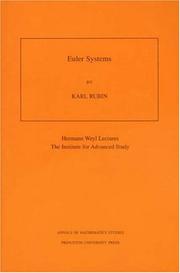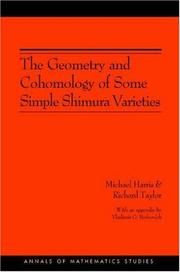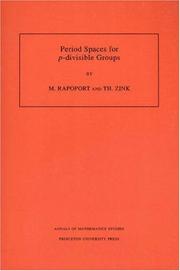| Listing 1 - 4 of 4 |
Sort by
|

ISBN: 0691050759 1400865204 9781400865208 0691050767 9780691050768 9780691050751 9780691050768 Year: 2000 Publisher: Princeton : Princeton University Press,
Abstract | Keywords | Export | Availability | Bookmark
 Loading...
Loading...Choose an application
- Reference Manager
- EndNote
- RefWorks (Direct export to RefWorks)
One of the most exciting new subjects in Algebraic Number Theory and Arithmetic Algebraic Geometry is the theory of Euler systems. Euler systems are special collections of cohomology classes attached to p-adic Galois representations. Introduced by Victor Kolyvagin in the late 1980's in order to bound Selmer groups attached to p-adic representations, Euler systems have since been used to solve several key problems. These include certain cases of the Birch and Swinnerton-Dyer Conjecture and the Main Conjecture of Iwasawa Theory. Because Selmer groups play a central role in Arithmetic Algebraic Geometry, Euler systems should be a powerful tool in the future development of the field. Here, in the first book to appear on the subject, Karl Rubin presents a self-contained development of the theory of Euler systems. Rubin first reviews and develops the necessary facts from Galois cohomology. He then introduces Euler systems, states the main theorems, and develops examples and applications. The remainder of the book is devoted to the proofs of the main theorems as well as some further speculations. The book assumes a solid background in algebraic Number Theory, and is suitable as an advanced graduate text. As a research monograph it will also prove useful to number theorists and researchers in Arithmetic Algebraic Geometry.
Algebraic number theory. --- p-adic numbers. --- Numbers, p-adic --- Number theory --- p-adic analysis --- Galois cohomology --- Cohomologie galoisienne. --- Algebraic number theory --- p-adic numbers --- Abelian extension. --- Abelian variety. --- Absolute Galois group. --- Algebraic closure. --- Barry Mazur. --- Big O notation. --- Birch and Swinnerton-Dyer conjecture. --- Cardinality. --- Class field theory. --- Coefficient. --- Cohomology. --- Complex multiplication. --- Conjecture. --- Corollary. --- Cyclotomic field. --- Dimension (vector space). --- Divisibility rule. --- Eigenvalues and eigenvectors. --- Elliptic curve. --- Error term. --- Euler product. --- Euler system. --- Exact sequence. --- Existential quantification. --- Field of fractions. --- Finite set. --- Functional equation. --- Galois cohomology. --- Galois group. --- Galois module. --- Gauss sum. --- Global field. --- Heegner point. --- Ideal class group. --- Integer. --- Inverse limit. --- Inverse system. --- Karl Rubin. --- Local field. --- Mathematical induction. --- Maximal ideal. --- Modular curve. --- Modular elliptic curve. --- Natural number. --- Orthogonality. --- P-adic number. --- Pairing. --- Principal ideal. --- R-factor (crystallography). --- Ralph Greenberg. --- Remainder. --- Residue field. --- Ring of integers. --- Scientific notation. --- Selmer group. --- Subgroup. --- Tate module. --- Taylor series. --- Tensor product. --- Theorem. --- Upper and lower bounds. --- Victor Kolyvagin. --- Courbes elliptiques --- Nombres, Théorie des

ISBN: 1400837200 9781400837205 0691090920 9780691090924 Year: 2001 Publisher: Princeton Princeton University Press
Abstract | Keywords | Export | Availability | Bookmark
 Loading...
Loading...Choose an application
- Reference Manager
- EndNote
- RefWorks (Direct export to RefWorks)
This book aims first to prove the local Langlands conjecture for GLn over a p-adic field and, second, to identify the action of the decomposition group at a prime of bad reduction on the l-adic cohomology of the "simple" Shimura varieties. These two problems go hand in hand. The results represent a major advance in algebraic number theory, finally proving the conjecture first proposed in Langlands's 1969 Washington lecture as a non-abelian generalization of local class field theory. The local Langlands conjecture for GLn(K), where K is a p-adic field, asserts the existence of a correspondence, with certain formal properties, relating n-dimensional representations of the Galois group of K with the representation theory of the locally compact group GLn(K). This book constructs a candidate for such a local Langlands correspondence on the vanishing cycles attached to the bad reduction over the integer ring of K of a certain family of Shimura varieties. And it proves that this is roughly compatible with the global Galois correspondence realized on the cohomology of the same Shimura varieties. The local Langlands conjecture is obtained as a corollary. Certain techniques developed in this book should extend to more general Shimura varieties, providing new instances of the local Langlands conjecture. Moreover, the geometry of the special fibers is strictly analogous to that of Shimura curves and can be expected to have applications to a variety of questions in number theory.
Mathematics --- Shimura varieties. --- MATHEMATICS / Number Theory. --- Varieties, Shimura --- Arithmetical algebraic geometry --- Math --- Science --- Abelian variety. --- Absolute value. --- Algebraic group. --- Algebraically closed field. --- Artinian. --- Automorphic form. --- Base change. --- Bijection. --- Canonical map. --- Codimension. --- Coefficient. --- Cohomology. --- Compactification (mathematics). --- Conjecture. --- Corollary. --- Dimension (vector space). --- Dimension. --- Direct limit. --- Division algebra. --- Eigenvalues and eigenvectors. --- Elliptic curve. --- Embedding. --- Equivalence class. --- Equivalence of categories. --- Existence theorem. --- Field of fractions. --- Finite field. --- Function field. --- Functor. --- Galois cohomology. --- Galois group. --- Generic point. --- Geometry. --- Hasse invariant. --- Infinitesimal character. --- Integer. --- Inverse system. --- Isomorphism class. --- Lie algebra. --- Local class field theory. --- Maximal torus. --- Modular curve. --- Moduli space. --- Monic polynomial. --- P-adic number. --- Prime number. --- Profinite group. --- Residue field. --- Ring of integers. --- Separable extension. --- Sheaf (mathematics). --- Shimura variety. --- Simple group. --- Special case. --- Spectral sequence. --- Square root. --- Subset. --- Tate module. --- Theorem. --- Transcendence degree. --- Unitary group. --- Valuative criterion. --- Variable (mathematics). --- Vector space. --- Weil group. --- Weil pairing. --- Zariski topology.

ISBN: 0691027811 1400882605 9780691027814 Year: 1996 Volume: 141 Publisher: Princeton (N.J.): Princeton university press
Abstract | Keywords | Export | Availability | Bookmark
 Loading...
Loading...Choose an application
- Reference Manager
- EndNote
- RefWorks (Direct export to RefWorks)
In this monograph p-adic period domains are associated to arbitrary reductive groups. Using the concept of rigid-analytic period maps the relation of p-adic period domains to moduli space of p-divisible groups is investigated. In addition, non-archimedean uniformization theorems for general Shimura varieties are established. The exposition includes background material on Grothendieck's "mysterious functor" (Fontaine theory), on moduli problems of p-divisible groups, on rigid analytic spaces, and on the theory of Shimura varieties, as well as an exposition of some aspects of Drinfelds' original construction. In addition, the material is illustrated throughout the book with numerous examples.
p-adic groups --- p-divisible groups --- Moduli theory --- 512.7 --- Theory of moduli --- Analytic spaces --- Functions of several complex variables --- Geometry, Algebraic --- Groups, p-divisible --- Group schemes (Mathematics) --- Groups, p-adic --- Group theory --- Algebraic geometry. Commutative rings and algebras --- 512.7 Algebraic geometry. Commutative rings and algebras --- p-divisible groups. --- Moduli theory. --- p-adic groups. --- Abelian variety. --- Addition. --- Alexander Grothendieck. --- Algebraic closure. --- Algebraic number field. --- Algebraic space. --- Algebraically closed field. --- Artinian ring. --- Automorphism. --- Base change. --- Basis (linear algebra). --- Big O notation. --- Bilinear form. --- Canonical map. --- Cohomology. --- Cokernel. --- Commutative algebra. --- Commutative ring. --- Complex multiplication. --- Conjecture. --- Covering space. --- Degenerate bilinear form. --- Diagram (category theory). --- Dimension (vector space). --- Dimension. --- Duality (mathematics). --- Elementary function. --- Epimorphism. --- Equation. --- Existential quantification. --- Fiber bundle. --- Field of fractions. --- Finite field. --- Formal scheme. --- Functor. --- Galois group. --- General linear group. --- Geometric invariant theory. --- Hensel's lemma. --- Homomorphism. --- Initial and terminal objects. --- Inner automorphism. --- Integral domain. --- Irreducible component. --- Isogeny. --- Isomorphism class. --- Linear algebra. --- Linear algebraic group. --- Local ring. --- Local system. --- Mathematical induction. --- Maximal ideal. --- Maximal torus. --- Module (mathematics). --- Moduli space. --- Monomorphism. --- Morita equivalence. --- Morphism. --- Multiplicative group. --- Noetherian ring. --- Open set. --- Orthogonal basis. --- Orthogonal complement. --- Orthonormal basis. --- P-adic number. --- Parity (mathematics). --- Period mapping. --- Prime element. --- Prime number. --- Projective line. --- Projective space. --- Quaternion algebra. --- Reductive group. --- Residue field. --- Rigid analytic space. --- Semisimple algebra. --- Sheaf (mathematics). --- Shimura variety. --- Special case. --- Subalgebra. --- Subgroup. --- Subset. --- Summation. --- Supersingular elliptic curve. --- Support (mathematics). --- Surjective function. --- Symmetric bilinear form. --- Symmetric space. --- Tate module. --- Tensor algebra. --- Tensor product. --- Theorem. --- Topological ring. --- Topology. --- Torsor (algebraic geometry). --- Uniformization theorem. --- Uniformization. --- Unitary group. --- Weil group. --- Zariski topology.
Book
ISBN: 0691197547 Year: 2019 Publisher: Princeton, NJ : Princeton University Press,
Abstract | Keywords | Export | Availability | Bookmark
 Loading...
Loading...Choose an application
- Reference Manager
- EndNote
- RefWorks (Direct export to RefWorks)
Arithmetic and Geometry presents highlights of recent work in arithmetic algebraic geometry by some of the world's leading mathematicians. Together, these 2016 lectures-which were delivered in celebration of the tenth anniversary of the annual summer workshops in Alpbach, Austria-provide an introduction to high-level research on three topics: Shimura varieties, hyperelliptic continued fractions and generalized Jacobians, and Faltings height and L-functions. The book consists of notes, written by young researchers, on three sets of lectures or minicourses given at Alpbach.The first course, taught by Peter Scholze, contains his recent results dealing with the local Langlands conjecture. The fundamental question is whether for a given datum there exists a so-called local Shimura variety. In some cases, they exist in the category of rigid analytic spaces; in others, one has to use Scholze's perfectoid spaces.The second course, taught by Umberto Zannier, addresses the famous Pell equation-not in the classical setting but rather with the so-called polynomial Pell equation, where the integers are replaced by polynomials in one variable with complex coefficients, which leads to the study of hyperelliptic continued fractions and generalized Jacobians.The third course, taught by Shou-Wu Zhang, originates in the Chowla-Selberg formula, which was taken up by Gross and Zagier to relate values of the L-function for elliptic curves with the height of Heegner points on the curves. Zhang, X. Yuan, and Wei Zhang prove the Gross-Zagier formula on Shimura curves and verify the Colmez conjecture on average.
Arithmetical algebraic geometry. --- Algebraic geometry, Arithmetical --- Arithmetic algebraic geometry --- Diophantine geometry --- Geometry, Arithmetical algebraic --- Geometry, Diophantine --- Number theory --- Abelian variety. --- Algebraic geometry. --- Algebraic independence. --- Algebraic space. --- Analytic number theory. --- Arbitrarily large. --- Automorphic form. --- Automorphism. --- Base change. --- Big O notation. --- Class number formula. --- Cohomology. --- Complex multiplication. --- Computation. --- Conjecture. --- Conjugacy class. --- Continued fraction. --- Cusp form. --- Diagram (category theory). --- Dimension. --- Diophantine equation. --- Diophantine geometry. --- Discriminant. --- Divisible group. --- Double coset. --- Eisenstein series. --- Endomorphism. --- Equation. --- Existential quantification. --- Exponential map (Riemannian geometry). --- Fiber bundle. --- Floor and ceiling functions. --- Formal group. --- Formal power series. --- Formal scheme. --- Fundamental group. --- Geometric Langlands correspondence. --- Geometry. --- Heegner point. --- Hodge structure. --- Hodge theory. --- Homomorphism. --- I0. --- Integer. --- Intersection number. --- Irreducible component. --- Isogeny. --- Isomorphism class. --- Jacobian variety. --- L-function. --- Langlands dual group. --- Laurent series. --- Linear combination. --- Local system. --- Logarithmic derivative. --- Logarithmic form. --- Mathematics. --- Modular form. --- Moduli space. --- Monotonic function. --- Natural topology. --- P-adic analysis. --- P-adic number. --- Pell's equation. --- Perverse sheaf. --- Polylogarithm. --- Polynomial. --- Power series. --- Presheaf (category theory). --- Prime number. --- Projective space. --- Quaternion algebra. --- Rational point. --- Real number. --- Reductive group. --- Rigid analytic space. --- Roth's theorem. --- Series expansion. --- Shafarevich conjecture. --- Sheaf (mathematics). --- Shimura variety. --- Siegel zero. --- Special case. --- Stack (mathematics). --- Subset. --- Summation. --- Szpiro's conjecture. --- Tate conjecture. --- Tate module. --- Taylor series. --- Theorem. --- Theta function. --- Topological ring. --- Topology. --- Torsor (algebraic geometry). --- Upper and lower bounds. --- Vector bundle. --- Weil group. --- Witt vector. --- Zariski topology.
| Listing 1 - 4 of 4 |
Sort by
|

 Search
Search Feedback
Feedback About
About Help
Help News
News